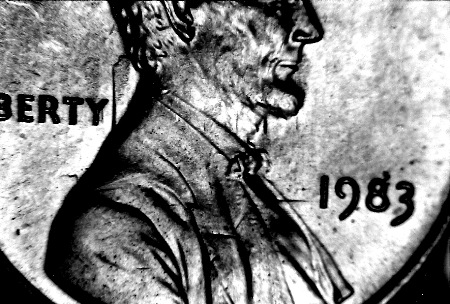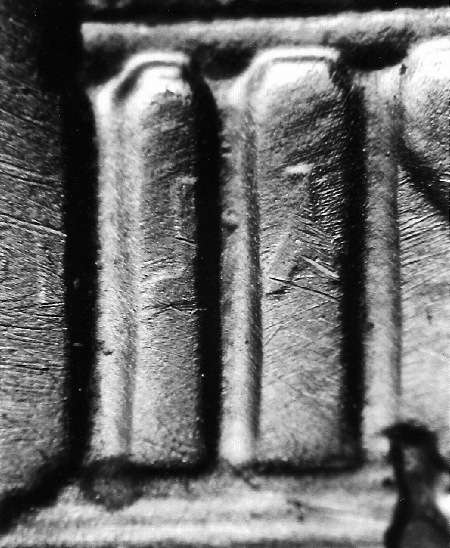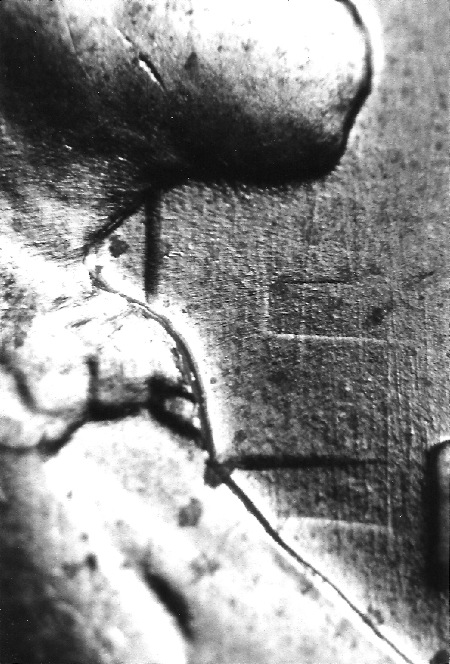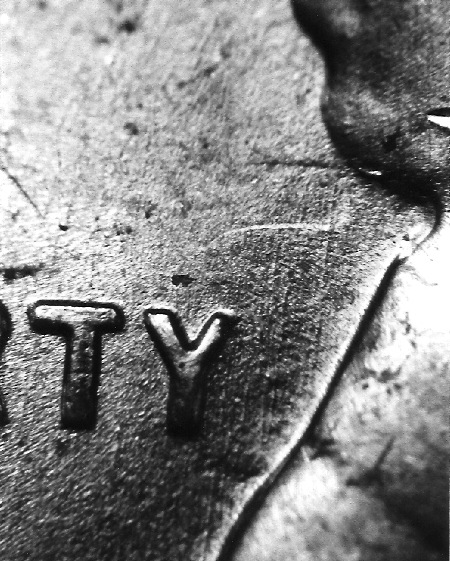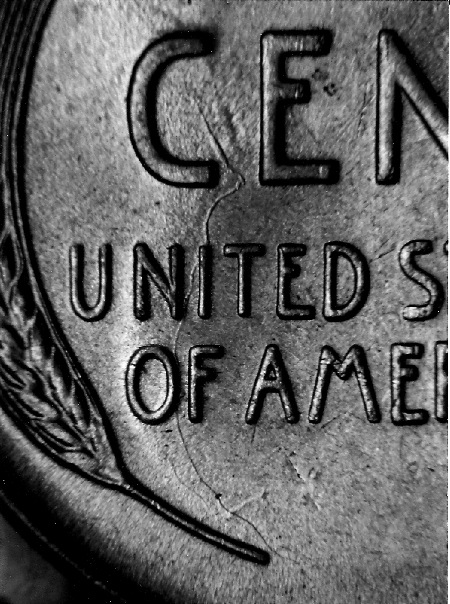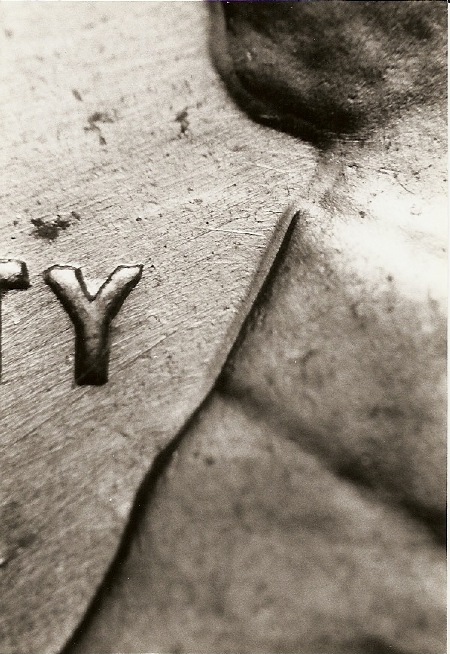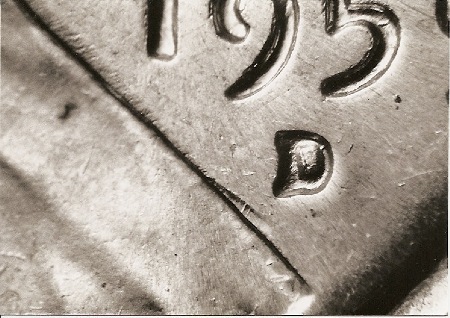


 |
 |
 |
 |
 |
 |
 |
 |
 |
 |
 |
 |
 |
 |
 |
 |
 |
 |
 |
 |
 |
 |
 |
 |
Another form of doubling that has been frequently confused with doubled die doubling is a form of doubling known as abrasion doubling. In fact, a number of specimens of abrasion doubling were actually once listed as doubled dies, so at one time it even fooled many of the "experts". This form of doubling gets its name from the fact that it is caused by rubbing an abrasive on the face of the die. This is done deliberately and as a matter of routine in an attempt to remove die clash marks. For those unfamiliar with die clashes and what causes them, a quick review of how coins are struck is in order. Planchets are struck by a pair of steel rods called dies. One die contains the obverse design and the other die contains the reverse design. In the coining presses a planchet is fed between the two dies and comes to rest on one of them (usually the reverse die) which is known as the anvil die. A collar surrounds the planchet to prevent the planchet metal from squeezing outward at the moment of impact in the striking of the coins. The hammer die (usually the obverse die) strikes the planchet with great force squeezing the planchet metal into the die cavities on both the obverse and reverse dies thus forming the design on the coin. Every now and then there is a malfunction in the mechanism that feeds the planchets into the coining chamber and a planchet will fail to be fed between the dies. The dies will come together without a planchet between them and strike each other. The force of the strike leaves part of the obverse design on the reverse die and part of the reverse design on the obverse die. When planchets subsequently are fed between the dies to be struck, the coins will bear these die clash images. On the Lincoln Memorial cents the clash marks appear as Memorial columns on the obverse which were usually seen behind the neck in the area of the TY of LIBERTY, below Lincoln's beard, and on some of the stronger clashes they are seen to the right of Lincoln's face and sometimes even on Lincoln's neck. On the reverse die the clash marks normally appear as an inverted TY of LIBERTY in the upper part of the first two Memorial bays and an incuse outline of Lincoln's beard in the bays to the right of the statue of Lincoln.
On this 1983 Lincoln cent we can see die clash marks on the Memorial columns to the left of the neck and just below the chin. The line running from the vest to the lower 1 in the date is a clash mark of the Memorial roof.
An inverted TY of LIBERTY is seen in the first two Memorial bays of this 1984 Lincoln cent. On the Lincoln wheat cents the clash marks on the obverse show as the inverted letters of ONE CENT seen in front of or behind the bust. The clash marks on the reverse of the wheat cents usually are seen between the lower C and E of CENT, but on stronger clashes can extend further down through the letters of UNITED and OF.
On this 1957-D Lincoln cent clashed die we can see part of the inverted N of CENT between the bowtie and the chin, part of the inverted T of CENT to the right of the bowtie, and part of the inverted E of ONE between the vest and the 1 in the date.
On the same 1957-D clashed die cent we can see part of the inverted C of CENT to the left of the neck and above the Y in LIBERTY.
The reverse of this 1939 Lincoln cent shows a strong die clash mark of the back of Lincoln's head, neck, and shoulder that runs from the area between the lower C and E of CENT all the way down to the tip of the left wheat stem. The technique for removing these die clash marks is to rub the surface of the die with an abrasive. If the die is abraded too vigorously in the area of the incuse design elements, the abrasive will eat into the surface of the die in those areas very much like the erosion that takes place in normal die deterioration. Again, these depressed areas from the abrasion process will appear as raised areas on the struck coins resulting in "doubling" of the affected letters or other design elements.
This 1956-D Lincoln cent with apparent doubling to the underside of the chin and to the throat was once listed as a doubled die. It appeared as 1956-D 1¢ LCDDO-014 in the first edition of The Authoritative Reference on Lincoln Cents but was later shown to be abrasion doubling. A similar variety on a 1957-D Lincoln cent which also had a genuine doubled die "extra eyelid" was found both with and without the throat doubling, something that would not be possible if the throat doubling were part of the genuine doubled die doubling. This one and a number of others with similar doubling were eventually deleted from the doubled die files.
Here we see abrasion doubling to the lower back of the head, the neck, and the vest collar. This is also on the 1956-D Lincoln cent that was once thought to be a doubled die variety.
Here we have a 1959-D Lincoln cent that shows abrasion doubling to the lower part of the vest. Some of these may still be out there labeled as doubled dies. The Roosevelt "hot lips" varieties are also an example of abrasion doubling. These were considered to be doubled dies by most experts until they were dismissed as misaligned die clash marks. However, abrasion doubling explains the co-occurrence with clashing and why the doubling does not align with overlays of the reverse. Here's a closeup of the former 1955-S 10¢ WDDO-001, which shows strongly doubled lips. Though this example is in a late die state, some small polishing lines from the attempt to remove the clash marks are still visible on and around the doubling.
Many of these dimes also have abrasion doubling on Roosevelt's forehead, like the former 1964-D 10¢ WDDO-002 here. There is an obvious gap in the doubling where the preceding clash mark is on this example.
On this 1964 "hot lips" dime, the doubling wraps around the chin and extends to the throat. Like on the forehead on other examples, there is a clear gap where the preceding clash marks are. The Lincoln cent and Roosevelt dime are not the only denominations with examples of this type of doubling. It can be found to some extent on all denominations of U.S. coins. Like mechanical doubling and die deterioration doubling, abrasion doubling is considered to be a form of die damage and not a collectible form of doubling. As a result, most serious collectors of doubled dies will not be interested in these and there is no premium assigned to coins displaying this form of doubling. Click on the following links to see the information on: | ||


